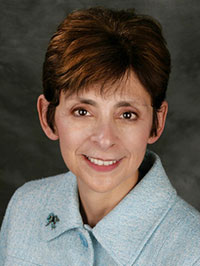How can teachers determine whether students are making appropriate progress?
Page 8: Communicate Progress
 While continuing to evaluate student performance and make instructional adjustments when necessary, it’s important that the educator regularly communicate a student’s progress with stakeholders (e.g., the student, parents, other professionals). Doing so is key for achieving a shared understanding of that student’s performance and instructional needs. The visual representation of the student’s performance provided by the graph can facilitate meaningful conversations with these stakeholders. Let’s briefly take a look at why communicating with students, parents, and other professionals is so important.
While continuing to evaluate student performance and make instructional adjustments when necessary, it’s important that the educator regularly communicate a student’s progress with stakeholders (e.g., the student, parents, other professionals). Doing so is key for achieving a shared understanding of that student’s performance and instructional needs. The visual representation of the student’s performance provided by the graph can facilitate meaningful conversations with these stakeholders. Let’s briefly take a look at why communicating with students, parents, and other professionals is so important.
Students are more motivated to maintain their efforts or work harder—and are more knowledgeable about their learning—when they are aware of their performance. And progress monitoring graphs can help them not only appreciate the relationship between their efforts and performance but set appropriate goals for themselves. Moreover, educators should emphasize a student’s individual growth rather than make comparisons to peers or to end-of-year benchmarks. Emphasizing a lack of progress can actually have a negative impact on a student’s motivation.
Parents report better communication with the educator when educators share progress monitoring data with them. Educators can show parents their child’s graph and discuss where improvement has occurred and where additional assistance or instructional changes may be needed.
Other Professionals may be involved in the student’s education. For example, an educator may need to discuss the student’s progress toward meeting IEP goals with the members of the IEP team.
individualized education program (IEP) team
A multidisciplinary team which includes educators, administrators, related service providers, parents, and the student with a disability that develops and evaluates the student’s individualized education program.
High-Leverage Practices
High-leverage practices (HLPs) are fundamental or foundational practices for general and special educators that are critical for student learning and improved outcomes. This module aligns with the following HLPs.
 General Education—HLP11: Talking about a student with parents or other caregivers. Learn more at TeachingWorks.
General Education—HLP11: Talking about a student with parents or other caregivers. Learn more at TeachingWorks.
 Special Education—HLP5: Interpret and communicate assessment information with stakeholders to collaboratively design and implement educational programs. HLPs for special educators were developed by CEEDAR and the Council for Exceptional Children (CEC). Learn more at High-Leverage Practices for Students with Disabilities.
Special Education—HLP5: Interpret and communicate assessment information with stakeholders to collaboratively design and implement educational programs. HLPs for special educators were developed by CEEDAR and the Council for Exceptional Children (CEC). Learn more at High-Leverage Practices for Students with Disabilities.
Research Shows
Decades of research have demonstrated the positive effects of communicating a student’s progress using GOM data.
- Studies have shown that students enjoy seeing their progress, are more aware of their progress, and feel more responsible for their own learning when provided with CBM information.
(Davis et al., 1995; Pemberton, 2004) - Parent-educator conferences are enriched and a collaborative partnership between the family and school are fostered when educators use CBM data to communicate a child’s progress to parents.
(Curry et al., 2016; Pemberton, 2003) - Teachers can use CBM data to engage with culturally and linguistically diverse (CLD) families of students with disabilities.
(Gerzel-Short et al., 2019) - Using CBM data facilitates the decision-making process when educators and professionals collaborate.
(Weiss & Friesen, 2014)
By using a graph, educators can easily provide concrete descriptions of student learning, which can help inform the team as they make instructional decisions. First, Lynn Fuchs describes how teachers can communicate with others using CBM graphs (time: 0:56). Next, Jessica Sellers describes how CBM graphs have helped her communicate student performance with parents and other professionals (time: 0:43).

Lynn Fuchs, PhD
Dunn Family Chair in Psychoeducational Assessment
Department of Special Education
Vanderbilt University
Transcript: Lynn Fuchs, PhD
CBM can be used to share information with other professionals. So at IEP meetings, a CBM graph can be used to make very concrete information about what adaptations the teacher has already tried in her classroom and what the effects of those adaptations have been on student achievement. When I was a teacher and I was using CBM and would go into an IEP meeting, it was very persuasive to other professionals about the fact that I really had tried some adaptations and that they hadn’t been effective. And that can be an important source of documentation for a regular classroom teacher to have to make his or her case that a child actually needs additional resources, besides what she can provide in her own classroom to affect adequate growth.
Transcript: Jessica Sellers, MEd
When I walk into an IEP meeting, I always feel better if I have a child’s CBM data with me because it’s so nice to be able to actually show parents how their child is doing using a graph. It also is a visual representation that guides me when I’m telling parents exactly what instructional methods we have tried to help their child and which ones are working and those that weren’t as successful. The parents I’ve worked with really appreciate giving them concrete information about how their child is doing.
When communicating with other professionals at pre-referrals or IEP team meetings, this is a great way for all of us to see how the child is doing and whether what’s going on in the classroom is working. It also helps me, because if I think a student needs a different placement, I have everything documented.
Activity
Ms. Wu has a parent-teacher conference scheduled this week with Raymond’s parents. She will use his graph to help facilitate their conversation. Using the graph below, as well as the other information you have about Raymond’s performance, describe three things Ms. Wu can tell Raymond’s parents about his mathematics performance.

- Although Raymond is working at a first-grade level in math, he is showing steady growth in his skills.
- Raymond is on track to meet his end-of-year goal.
- No instructional changes are needed at this time. Ms. Wu will continue collecting data.
